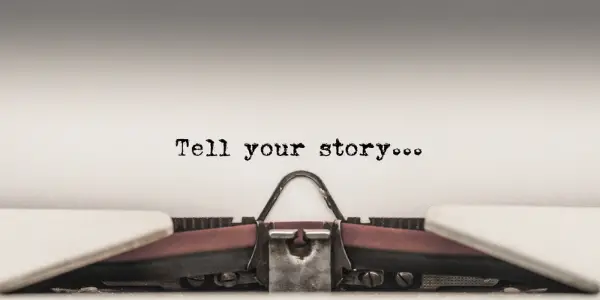Regardless of how good the job market is, landing a top job requires that you stand out from the other applicants. And, I’ll let you in on a little secret: using the latest resume template, buzz words, or a laundry list of skills isn’t going to do it.
What you need is a career story. People love stories. When you tell a meaningful story about your journey, it can build trust and empathy before entering a room. Telling your career story can be a compelling way to let a future interviewer in on what you do best, how you got to where you are and, most importantly, what makes you uniquely perfect for the job.
Bottom line: stories resonate with people on a fundamental level, and letting someone in on your story can help you get your foot in the door to have more conversations.

How we communicate with story
Storytelling is universal to every culture and the human experience. According to National Geographic, stories allow us to share information in a memorable way, which might’ve helped our ancestors survive. The story format of delivering otherwise dry or boring information can make it more compelling and meaningful to the reader. A good career story can help an interviewer feel a connection to you.
The #1 Wall Street Journal Bestselling book, Building A StoryBrand, explains that our brains don’t know how to process complex information. Simple stories help because they help the brain make sense of information and make it easier to digest. Stories ”put everything in order so the brain doesn’t have to work to understand what’s going on.”
One thought before you get started
There are many things to keep in mind when writing your career story, but there is one absolute must. You owe it to yourself to be completely truthful in telling your story. Don’t embellish or augment your story to make it sound more exciting or compelling.
It’s a satisfying experience to discover and tell your own authentic story. It may even help you see patterns in your life and understand what you want out of life. Everyone has a story and everyone’s story matters. Including yours.

Write your career story
There are many story frameworks to use, but many of them are very similar, as people tend to like stories told in a certain way. We’ll go with a basic format.
Remember: simplicity rules. The reader should be able to understand what you are all about with a simple story that they can easily understand and trust. It should convey your personality and your voice. The goal is to connect with the reader in an authentic way.
Now, if you’re early in your career, you may think that you have no career story to tell. I respectfully disagree. We’ve all lived our own stories, and your life has likely had many ups and downs personally, in a school setting, or at part-time jobs or internships you’ve held. Use those experiences within the steps listed below.
Prepare to write
1. Clarify your goal in telling your story
Write a simple sentence about your purpose in telling your career story. Is it to get a new job? To go out for a promotion? Are you applying for an advanced degree program or trying to get a speaking assignment?
Regardless of the reason, clarify it for yourself by writing it down in one simple sentence. ”The goal of my career story is…”
2. Consider your audience’s expectations, needs and fears
Interviewers are often wading through dozens or even hundreds of resumes and applications. It’s hard to stand out with standard statements such as ‘exceptionally organized and detail oriented’ or ’a team player’.
Also, keep in mind that interviewers are human, and they have real fears about not being able to find the right person, or even worse, hiring the wrong person, which may lead to months of performance management.
The person has limited time, energy, and attention to devote to filling a role, and they need to be able to identify the right people to interview. A good career story can captivate an interviewer and convince them that you’re worth their time and energy.
Write down 2-3 expectations, needs and fears a person reviewing your career story may have.
3. Make a list of experiences that’ve impacted you, successes you’ve achieved, and obstacles you’ve overcome
Think about your best attributes and any situations in your past that help demonstrate these positive attributes about you.
Some examples:
- If leadership is your best quality, consider situations where you’ve demonstrated that skill. Maybe you led a student government, led a major project, or led a company. Also, consider how you became this way. Are you the oldest sibling who had to take on extra responsibility? Do you have experiences that made you realize the value of excellent leadership?
- If organization is your best quality, think about times you’ve used organization to make a difference on a project or in a job. Do you have a funny story about organizing some item in your life or maybe a family member or friend’s house?
- If you’re a natural collaborator, consider how that has helped you achieve past goals. Maybe there is something that couldn’t be done until you pulled several great minds together to work on a solution. Maybe you brought camaraderie to a dysfunctional team, resulting in getting work done in record time while having fun.
Write down a few of your best qualities and note a story or two that demonstrates that quality and/or why you developed or value that quality.

Write your story
With all the information you’ve gathered above, you’re now ready to weave together a story that is compelling while simple and easy to read and understand.
This isn’t an exercise in writing a journal entry or a rambling essay and it doesn’t need to rehash information that is in your resume such as your educational background or job experience. This is a story focused on selling yourself.
1. Beginning: What is the problem?
Start with a problem that will set up the story you’d like to share about yourself. Get a bit creative here. Find a compelling way to set up your story.
Maybe you’re sharing a story about why you do the work you do (or want to do). Were you spending your days staring at the clock, and realized you were wasting all of your talents on work that didn’t speak to your heart? Did you find a process that didn’t work, and it bothered you so much that you couldn’t stop thinking about it? Were you in a setting where people with serious potential were not being properly developed for their next role?
Think about the problems you solve with your unique skill set. Pull the reader into your story with a compelling problem that needs to be solved.
Find ways to weave in why you care about this type of problem. Did you experience a career stall due to a lack of self-confidence or development opportunities? Are you drawn to order and organization because of something that happened in your life? Explain why you care about this particular type of problem.
2. Middle: How did you solve the problem?
You’ve set up the problem and drawn the reader in, now how did you solve that problem?
Let’s take the example of experiencing the problem of working with a lot of great people with high potential. But, you recognized that they weren’t given proper development opportunities. How did you solve that problem? Did you start a leadership club, book club, or mastermind group for the high potential people? Did you recommend someone for a high-profile project? Did you set up a mentorship program or get funding for a leadership development conference?
The middle should convey your solution to the problem and how you think about issues. Dig deep into why you are who you are and why you care about solving this type of problem.
3. End: What kind of success did you achieve?
Explain what happened once you implemented the solution described above and how you and others benefitted from the solution. The end should be a success story where you use a skill you have to achieve something that matters to you.
For example, were you able to set up a new process that reduced processing time and made it easier to best serve your customer? Were you able to see an increase in promotions within the company due to your leadership program? Were you able to create a more cohesive team that won company awards?
Lastly, the end of the story must leave the reader with two things:
- The employer must be able to envision success by employing you, and
- A call to action, in which you invite them to call you or email you.
4. Edit, edit, edit
Once you’ve written a beginning, middle, and end you are happy with, the next step is editing your story to perfection. Any words you’ve written that don’t provide key information or advance your story need to be cut, regardless of how clever or interesting you find them.
Your career story needs to be short, compelling and to the point. Write and re-write it until is 500 words or less, but still makes all the important points.
Here are some key things to think about while editing your story:
- Remove all pointlessly fancy or formal language. Don’t use pretentious wording – it does not make you seem smarter. Use common words – it’s about telling a story that helps another person to know and understand what you could bring to a role.
- Remove all jargon, buzz words, and cliche.
- Be on the lookout for redundant words or words you can remove because they are implied.
- Eliminate parts of your story with too much detail.
- Determine if any points in your writing are unclear or if you’ve too many words to describe something.
- Ask yourself: Is your story clear and logical from beginning to end? And are you sticking to mostly active voice?
- Make sure your writing flows well from beginning to end.
- Most importantly, make sure you would want to learn more if you read this story.

Finishing touches
I use Grammarly.com to review all of my writing (including this blog post). They have both a free and paid version. The free version will catch any basic mistakes such as spelling grammar and punctuation. I use the premium version, which also provides style, tone and clarity suggestions.
Consider hiring an editor from Fiverr or Upwork to review and edit your career story. You should be able to find someone who is five-star rated for $50 or less. Tell them your goal of simplicity, clarity, and compelling copy that sells you as [insert whatever your goal is].
You did it!
Now that you have a compelling, well-crafted career story, you can use it in so many places. Use it in your LinkedIn profile, in place of a cover letter, on a blog, when competing for speaking assignments, or when applying for membership to a professional organization.
You can also use it to tell your story to people you meet at networking events or conferences. When someone asks ”what do you do,” you’ll be able to leverage the story you wrote to communicate what you bring to the workplace and why.
Remember, everyone has a story to tell. So many experiences have shaped you into who you are today. The trick is getting clear on your goal and then finding the experiences that help you communicate your story.
Once you have your career story nailed down, get that professional headshot and suit up to really stand out above the rest!

